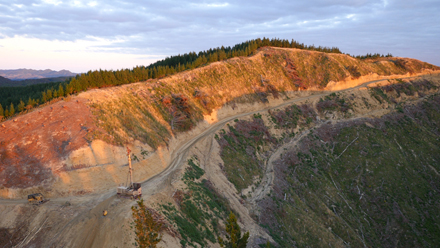 An increase in forestry harvests dubbed the “Wall of Wood” is expected to bring jobs and opportunities to regional New Zealand but will also present infrastructure challenges. Source: The New Zealand Herald
An increase in forestry harvests dubbed the “Wall of Wood” is expected to bring jobs and opportunities to regional New Zealand but will also present infrastructure challenges. Source: The New Zealand Herald
Wood availability is forecast to increase rapidly leading into the 2020s in New Zealand with most of the increase from small-scale growers who established forests during the 1990s.
Hawke’s Bay Regional Council forestry specialist James Powrie said employment in harvesting, forest engineering, shipping and log transport was likely to rise with harvest volumes.
“Skilled workers and effective contractors will be at a premium, to ensure safe, profitable and environmentally acceptable harvest.”
Napier Port chief executive Garth Cowie said the volume of logs coming through the port would more than double by 2020.
“It’s known in the industry as the ‘Wall of Wood’, and it’s crucial that we’re ready for it.” Mr Cowie said the port had invested NZ$8.2 million in sealing its main log yard and purchasing higher bookends that allowed it to stack a greater volume of logs.
“Where previously we loaded logs for export from a single wharf, we are now loading across multiple wharves.”
Forest Owner Marketing Services director Marcus Musson said harvests would increase markedly in the southern North Island, creating jobs. However, the availability of skilled workers in the industry could be a concern.
As time went on, forestry would be seen as a good career option for young people. The industry had been cyclical historically and large fluctuations in the market led to changes in the availability of work.
“Because there is going to be so much wood available, those fluctuations are probably going to be lessened. So we’re going to have a more stable working environment for the guys, which will then generate a more stable workforce.” He said a lot of forests were planted a reasonable distance from town and some roads hadn’t been constructed to cope with the level of heavy traffic needed.
“There’s going to be quite a requirement for road upgrades in some of the rural areas,” said Mr Musson.
Bay of Connections Forestry strategy head, Bryce Heard, said the Central North Island area was New Zealand’s largest forest resource.
He said forestry growth opportunities for the region included wood and wood fibre processing as well as replanting.
Potential revenue growth from the forestry and wood sector was estimated at $6 billion annually, with the majority of the increase coming from exports.
Associate Professor at the University of Canterbury School of Forestry, Dr Rien Visser, said trying to market the increased volume of material could be a concern.
New Zealand was very dependent on the Chinese market and it was hard to predict their needs.
The sector was trying to develop the Indian market as an alternative.
Retrospectively, it wasn’t necessarily a good idea to plant such a large amount of forest at once in the nineties.
“At the time there was obviously the perception that the world needed a whole lot more wood, but that’s never really panned out. So obviously we’re going to electronics a lot more and there simply isn’t always that very, very large demand for wood products.
“We’re dealing with the implications of that really sudden land use change. But conversely, what’s happening now is that we’re planting so few forests that we’ve actually got a massive decline in forested landscape. So that’s going to come up as a real issue as well. So we’ve gone from one extreme to the other.”
Scion Research principal scientist Dr Tim Payn said there would certainly be a peak in trees maturing but they didn’t have to be harvested in any one year.
People could work cooperatively in a region to smooth out the wood flow. It was common for small growers to work cooperatively internationally and it was expected to become more common in New Zealand, Dr Payn said.





